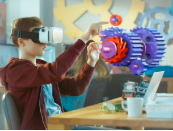STEM education—focused on Science, Technology, Engineering, and Mathematics—has always been about solving real-world problems and encouraging innovative thinking. In today’s classrooms, a powerful tool is helping to bring STEM concepts to life like never before: Augmented Reality (AR). This exciting technology is changing the way students learn and engage with complex ideas.
What Is Augmented Reality in Education?
Augmented Reality blends digital content with the real world. Unlike virtual reality, which immerses users in a fully digital environment, AR layers interactive visuals, sounds, or data onto physical surroundings using devices like smartphones, tablets, or AR glasses. In an educational setting, this means students can interact with 3D models, simulations, and animations that appear right in front of them.
Bringing Abstract STEM Concepts to Life
One of the biggest challenges in teaching STEM subjects is helping students visualize and understand abstract concepts. AR helps bridge that gap. For example:
In biology, students can explore detailed 3D models of the human body or visualize the process of cell division.
In physics, learners can experiment with simulations that demonstrate forces, motion, or electricity without the need for complex lab equipment.
In engineering, AR can display structural designs in 3D, allowing students to examine and even modify components in real time.
In mathematics, dynamic AR visualizations can turn geometry and algebra problems into interactive learning experiences.
These tools help improve comprehension and retention by turning passive lessons into active learning sessions.
Boosting Engagement and Motivation
Augmented Reality makes learning more interactive and enjoyable. It captures students’ attention and keeps them interested in subjects that can sometimes feel intimidating. By using AR apps and experiences, students can take part in virtual science experiments, solve engineering puzzles, or explore the solar system in their own classroom. This level of interaction often leads to greater motivation and a deeper understanding of the content.
Making STEM Education More Inclusive
AR technology can support diverse learning needs. Visual and hands-on learners benefit from seeing and manipulating 3D models. Students who need extra support can review content at their own pace through AR-enabled tools. Additionally, AR can reduce the cost of traditional lab equipment and materials, making high-quality STEM experiences more accessible to schools with limited resources.
Preparing Students for Future Careers
AR isn’t just a classroom novelty—it reflects real tools used in modern industries. Engineers, doctors, architects, and data scientists increasingly rely on AR in their work. By integrating AR into STEM education, students are gaining early exposure to technologies they may use in their future careers. It helps them develop technical skills and fosters an adaptive mindset in a fast-changing world.
Final Thoughts
Augmented Reality is transforming STEM education by making lessons more engaging, accessible, and aligned with future job skills. As technology continues to evolve, AR will likely play an even greater role in how students explore, understand, and apply knowledge in the STEM fields. With the right tools and guidance, today’s learners can build a stronger foundation for tomorrow’s challenges—one interactive lesson at a time.













